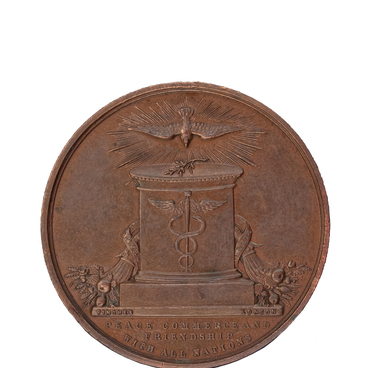In late 1855, Emperor Alexander II issued an edict to the Minister of War “On the establishment of medals for those who participated from September 13, 1854, to August 27, 1855, in the defense of the city of Sevastopol.” In the edict, the emperor wrote, “Brave soldiers of the Crimean army! my meeting you was a great pleasure for me. I was glad to see you and I admire you <…> In memory of the famous and glorious defense of Sevastopol, for the troops defending the fortifications I established a silver medal on the St. George ribbon for wearing in the buttonhole.” The medal is considered the first award that was given not for defeating an enemy or capturing a city but for defense.
The medal “For the Defense of Sevastopol” was cast in silver at the St. Petersburg Mint in 1855. The diameter of the award is 2.8 centimeters. The obverse depicts the monograms of Emperors Nicholas I and Alexander II below two imperial crowns. The reverse features an inscription “For the defense of Sevastopol”.
In the center, under the image of the “eye of providence”, there are dates of the beginning and the end of the defense — “From September 13, 1854, to August 28, 1855”. A small eyelet is attached to the top so that the award can be worn in a buttonhole. The medal was supposed to be worn on the St. George ribbon or a rectangular metal suspension device.
The first 100,000 medals were minted for the War Ministry in 1856, another 20,000 were made for the admiralty. According to various estimates, more than 248,000 copies of the medal “For the Defense of Sevastopol” were produced by 1862. The defense participants received it up to 1870.
However, the medal was intended not only for the militarymen but also for everyone who participated in the defense of the city. In addition to the ranks of the ground and naval departments, by the Imperial command, the award could be received by civilian officials who were in Sevastopol on duty, residents who participated in the defense, as well as women who worked in hospitals. Even children were among those who were given the award, and since February 25, 1856, the Sevastopol medal was awarded to clergymen who were in the city during the siege.
The award housed by the museum belonged to Anna Fyodorova, a Sevastopol resident, the wife of the sailor of the 30th naval crew Ilya Fyodorov. During the bombing, she was in the battery of Lieutenant Vladimir Brylkin, where she helped the wounded and sewed peak caps. On December 5, 1855, by the order of Alexander II, Anna Fyodorova was awarded a silver medal on the St. George ribbon.
The medal “For the Defense of Sevastopol” was cast in silver at the St. Petersburg Mint in 1855. The diameter of the award is 2.8 centimeters. The obverse depicts the monograms of Emperors Nicholas I and Alexander II below two imperial crowns. The reverse features an inscription “For the defense of Sevastopol”.
In the center, under the image of the “eye of providence”, there are dates of the beginning and the end of the defense — “From September 13, 1854, to August 28, 1855”. A small eyelet is attached to the top so that the award can be worn in a buttonhole. The medal was supposed to be worn on the St. George ribbon or a rectangular metal suspension device.
The first 100,000 medals were minted for the War Ministry in 1856, another 20,000 were made for the admiralty. According to various estimates, more than 248,000 copies of the medal “For the Defense of Sevastopol” were produced by 1862. The defense participants received it up to 1870.
However, the medal was intended not only for the militarymen but also for everyone who participated in the defense of the city. In addition to the ranks of the ground and naval departments, by the Imperial command, the award could be received by civilian officials who were in Sevastopol on duty, residents who participated in the defense, as well as women who worked in hospitals. Even children were among those who were given the award, and since February 25, 1856, the Sevastopol medal was awarded to clergymen who were in the city during the siege.
The award housed by the museum belonged to Anna Fyodorova, a Sevastopol resident, the wife of the sailor of the 30th naval crew Ilya Fyodorov. During the bombing, she was in the battery of Lieutenant Vladimir Brylkin, where she helped the wounded and sewed peak caps. On December 5, 1855, by the order of Alexander II, Anna Fyodorova was awarded a silver medal on the St. George ribbon.



